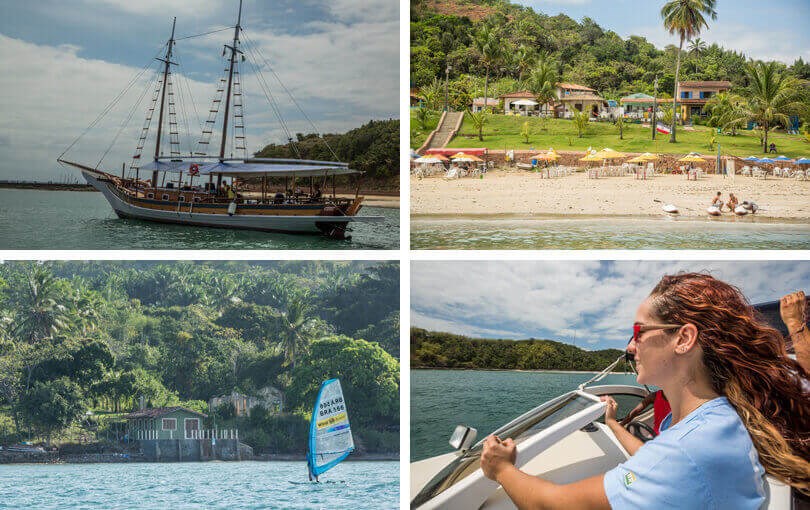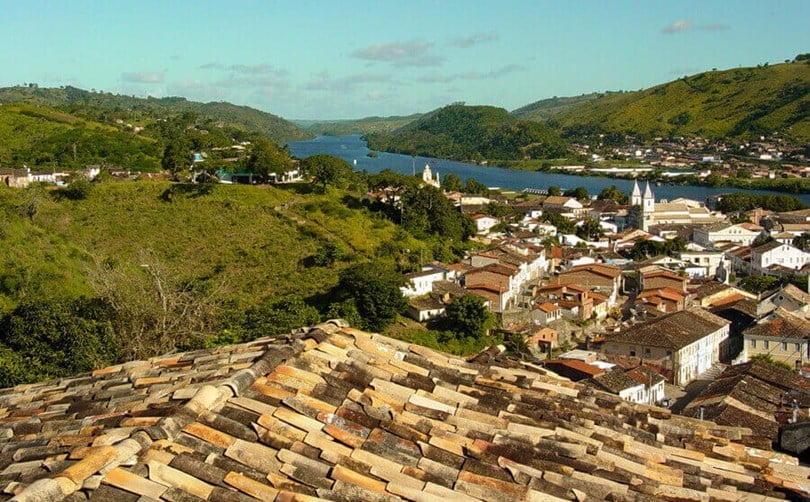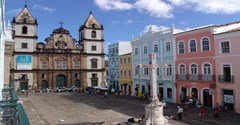Discover our favourite things to do in Salvador, taking an authentic journey to the cultural heart of this dynamic coastal city.
It was Brazil's very first capital, is one of the oldest colonial cities in Latin America and is thought to be the largest African city outside of Africa. Yet these claims to fame do little to express what makes Salvador one of the continent's most captivating and culturally-rich destinations.
Salvador is a full sensory experience, with sights, sounds and enticing aromas that will stay with you long after your visit. But its charm resides as much in its intangible laid-back atmosphere and exotic feel and its many layers of cultural elements makes it a wonderful city to delve deeper into. We offer seven of our favourite ways to experience Salvador de Bahia, all of which can be enjoyed as full or half-day excursions as part of your stay here with Veloso Tours.
1. Ride the Lacerda Elevator to explore colourful Pelourinho
Much of Salvador's centre is split between the lower Comercio district and the higher Centro. The lower part is more developed and less picturesque, but is noted for its interesting Mercado Modelo flea market, old docks and the port area from which boat trips into All Saint's Bay set off. A short ride up the art deco Lacerda Elevator affords panoramic views of the bay and brings you to the Municipal Square in the upper part.
Salvador is a city of Afro-Portuguese influences, manifested in expressive dances, powerful drumming and an aromatic cuisine. It has been a prolific producer of writers, poets and musicians - an artistic nature reflected in the Pelourinho's colourful colonial era facades. It might sound a bit odd for a city so heavily populated and influenced through the years by African slaves, but the name of Salvador's most emblematic neighbourhood actually derives from the word for whipping post, where their ancestors might have been brought and sold.
Among the highlights here are the fine views from Praca da Se, the wide range of cultural museums and the richly-decorated golden interiors of the Sao Franciso baroque church and the Cathedral Basilica on Praca Terreiro de Jesus. The beautiful houses, intricate churches and cobbled squares also provide the backdrop to a vibrant city life, with high-flying Capoeira dances popping up unannounced and lively bars and restaurants spilling out onto the streets.
 Colourful colonial buildings of Pelourinho & Lacerda Elevator (by Visit Brasil & Veloso Tours)
Colourful colonial buildings of Pelourinho & Lacerda Elevator (by Visit Brasil & Veloso Tours)
2. Visit Barra's historic lighthouse on the site of Salvador's first settlement
To the south of the historic centre, at the start of the All Saint's Bay, is the coastal district of Barra. It was here that intrepid Portuguese explorers first established the city back in the 16th century, forming Brazil's first capital. Today its most famous landmark is the lighthouse, which forms part of the impressive Santo Antonio Fort.
The colonial fort formed part of the defense system created to ward off the threat of Dutch invaders in the 17th century and today houses the city's Nautical Museum, which tells of the early days of Portuguese exploration in Salvador. Wonderful views across the bay can also be enjoyed from here, particularly at sunset, and the popular nearby Porto da Barra beach is one of the best in Salvador.
 Santo Antonio Fort & Barra Lighthouse (by Visit Brasil)
Santo Antonio Fort & Barra Lighthouse (by Visit Brasil)
3. Join the pilgrims and make a wish at the Bonfim church
In the opposite direction to Barra, this time to the north of the centre, is another Portuguese fort - Monte Serrat. Just like Santo Antonio, it is a wonderful place from which to enjoy the sun setting across All Saint's Bay. However it is far from the only point of interest on the Itapagipe Peninsula
The Bonfim Church boasts two distinctive colonial-style towers on the outside and an elegant interior, with beautiful murals adorning the wooden ceilings. But it is its miracle-producing capabilities, rather than any aesthetic features, which define this famous church. Brightly-coloured ribbons (fitas) are handed out and worn around the wrists of visitors and pilgrims to the city, who are granted their wishes when the three knots work themselves loose and fall off naturally. Many prefer to tie them to the huge mass already hung on the gates of the Bonfim church, adding their hopes and dreams to the thousands who came before them.
The theme continues inside the adjacent museum, where plastic body parts are hung eerily from the ceiling in prayer of a speedy recovery. Underneath these, the walls are covered with photographs and messages of thanks from grateful devotees, creating a bizarre yet heart-warming and endearing spectacle. Each January brings the ceremonial washing of the Bonfim steps and accompanying feast, a lively event which draws pilgrims from far and wide.
 Church of Bonfim & Museum of Ex-votos (by Visit Brasil)
Church of Bonfim & Museum of Ex-votos (by Visit Brasil)
4. Join the crowds to watch a lively Olodum rehearsal
Olodum is a musical and social phenomenon that started in Salvador in the late seventies, born out of a desire to raise awareness of discrimination and connect disaffected youths with their West African roots. In this way, it is one of the most endearing and expressive blends of African and Brazilian heritage, coming together to form a new Bahian identity and a source of pride for a younger generation. Such has been the sudden rise to fame, the Olodum group has performed alongside internationally acclaimed music stars, including the late Michael Jackson.
The group produces instruments and costumes to sell to visitors and remains politically active in the local community, but the heart of Olodum will always be the music. Unmistakably Brazilian drumming is overlaid with lively rhythms to create a distinct samba-reggae style, which together with the colourful drums, hand-painted in the reds, golds, greens and blacks, creates an energetic and uplifting spectacle. Huge crowds gather to watch the group hold its weekly rehearsals, particularly in the run up to carnival seasons. Joining them is a quintessentially Bahian experience.
 Olodum drumming rehearsal (by Visit Brasil)
Olodum drumming rehearsal (by Visit Brasil)
5. Marvel at acrobatic Capoeira dance moves
Another typically Bahian cultural icon is the acrobatic martial-art-cum-dance-form Capoeira. Just like Olodum, the dance has its roots firmly in Africa (more specifically in Angola) and traces its origins back to the 16th century slave workers of Bahia's highly productive sugar cane plantations.
The group of participants, traditionally dressed in pristine white trousers, form a circle alongside those strumming a berimbau (a bow-like percussion instrument) to set the rhythm. The 'fighters', who regularly interchange, swing spectacular high kicks and low sweeps in each others' direction, dodging, ducking, dancing, swivelling, cartwheeling and spontaneously back-flipping to avoid being hit. Therein lies the artistic essence of Capoeira - the skill is in not hitting your opponent in the most arresting way possible.
The action is fast-paced, completely unscripted and utterly hypnotic, not least during those special moments when the two contestants fall into perfect sync, connecting on a series of meticulously timed inter-linking movements. The crowds are whipped into a frenzy, completely sucked in to the artistry and intensity of the spectacle.
Capoeira can seen on the streets of the Pelourinho during the day or by visiting various Capoeira schools or enjoyed with dinner at one of our preferred Bahian folklore shows, alongside other Bahian dance forms, such as maculele.
 Capoeira street performance (by Turismo Bahia)
Capoeira street performance (by Turismo Bahia)
6. Take a schooner ride around the exotic islands of All Saint's Bay
The bay is so named because it was first entered by European explorers on All Saint's Day (November 1st) over 500 years ago. Aside from the distant Salvador skyline, not too much has changed through the years on the many tiny uninhabited islands of Brazil's largest bay. In total it covers a surface area bigger than Bedfordshire, but its not the mere size that makes All Saint's Bay so remarkable.
The crystal-clear water and inviting tropical islands spread throughout make it a wonderful place in which to spend a day cruising aboard a traditional schooner boat, soaking up the sun and admiring sweeping panoramic views of Salvador. You can relax on idyllic beaches, take short hikes through verdant Mata Atlantica forest, enjoy a leisurely lunch in scenic surrounds and dive into the calm waters to swim or snorkel.
 Tropical islands of All Saints Bay (by Visit Brasil)
Tropical islands of All Saints Bay (by Visit Brasil)
7. Discover the sugar plantations and cigar factories of the Recôncavo
As spectacularly evidenced in the Olodum drumming and Capoeira dances, Salvador's African heritage continues to permeate the city's culture and everyday life, giving it a feel so distinct from any other. The arrival of African slaves to the city can be traced back directly to the sugar plantations of the nearby fertile Recôncavo Baiano region. Along with the tobacco farms and cotton fields, it was a source of instant prosperity and enriched the local area, not least the towns of São Félix and Cachoeira, linked by a large rusty bridge which crosses the Paraguaçu River.
The wealth has long since departed with declining trade, but today Cachoeira in particular retains a charming 'old glory' feel, with traditional colonial era houses and baroque bridges recalling grander times and folkloric tales. It also preserves a uniquely Bahian culture, primarily in the Sisterhood of Our Lady of the Good Death Candomble religious group, who parade in their large traditional white dresses each August.
Our visits to Cachoeira coincide with tours of one of the remaining sugarcane and cocoa plantations, a boutique traditional cigar factory and an open air market selling the exotic fruits grown in the fertile grounds of the Recôncavo.
 View across rooftops to Cachoeira, Bahia (photo by Adam Jones)
View across rooftops to Cachoeira, Bahia (photo by Adam Jones)
Visiting Salvador
Arrival: Salvador de Bahia can be reached on daytime flights via Lisbon with Air Portugal or via Madrid with Air Europa.
When to Go: Salvador can be visited all year round, with temperatures generally staying at least in the low twenties. The city inevitably gets very busy in February when carnival season arrives and April to June brings higher humidity and greater chance of rain. The summer months (December to February) offer the warmest temperatures and lowest rainfall, but also attract bigger crowds.
Eating & Drinking: One of the dishes for which Salvador is best known is acarajé - a small street food snack made with black eyed peas, which is then deep fried in palm oil, cut open and filled with various fillings, typically a shrimp-based paste. Other mainstays of Bahian cuisine include the fish-based stews vatapá and moqueca and the versatile farofa, manioc flour fried or toasted and served with feijoada baiana (a meat-laden stew typically cooked in Bahia with kidney beans and served with rice). Brazil's national drink is the cachaça-based cocktail caparinha; sugarcane rum mixed with lime, crushed ice and sugar.
Where Next: Salvador can easily be combined with laid-back beach villages of Praia do Forte or Morro de Sao Paulo and around five hours by road inland is the magnificent Chapada Diamantina. This large national park is charactarised by powerful flat-top mountains, towering waterfalls, inviting lagoons and underground caves bathed bathed in green and blue light. Further afield, the most popular places to combine with Salvador are Rio de Janeiro, the Pantanal wetlands or a stay at a specialist Amazon Lodge.
The best way to plan your visit to the city is to browse our selection of tours to Salvador, including our 6 night Salvador City Break, which allows greater exploration of the city and time for plenty of the activities and excursions described above. If you are thinking of visiting Brazil, we'd love to discuss your ideas with you.
Choose your perfect holiday
Find inspiration from our selection of itinerary suggestions, a great starting point for your next trip
View More Tours
Stay in touch
Infuse your travels, with inspiration from our monthly newsletter.
READY - 12 April 2024
INDIA: Fascinating Culture & Kembh Mela Festival
LANDMARK TOURS: Multi-Country & Cross Continent. New Cosmopolitan Tour: Buenos Aires, Iguazu, Rio
CHINA & INDIA: Local Life, People & Unique Cultures
GUIDES by Veloso Tours, are the best Local Hosts
PRIVATE VILLAS: Quality Time in exclusive settings
TRAVEL INSURANCE with extensive COVID-19 cover


